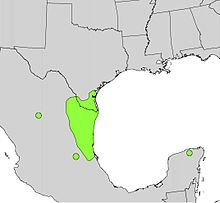Ebenopsis ebano is a species of flowering plant in the family Fabaceae,[2] that is native to the coastal plain of southern Texas in the United States and eastern Mexico.[3] It is commonly known as Texas ebony or ebano (in Spanish).[2]
| Ebenopsis ebano | |
|---|---|
 | |
| Fruit | |
| Scientific classification | |
| Kingdom: | Plantae |
| Clade: | Tracheophytes |
| Clade: | Angiosperms |
| Clade: | Eudicots |
| Clade: | Rosids |
| Order: | Fabales |
| Family: | Fabaceae |
| Subfamily: | Caesalpinioideae |
| Clade: | Mimosoid clade |
| Genus: | Ebenopsis |
| Species: | E. ebano |
| Binomial name | |
| Ebenopsis ebano | |
 | |
| Natural range | |
| Synonyms | |
Acacia flexicaulis Benth. | |
Description
Texas ebony is a small, evergreen tree that reaches a height of 7.6–9.1 m (25–30 ft) and a crown width of 1.8–4.6 m (5.9–15.1 ft).[4]

Habitat and range
The range of E. ebano stretches from Laredo and Corpus Christi, Texas[5] south through the states of Tamaulipas, Nuevo León, San Luis Potosí, Veracruz, Campeche, and Yucatán in Mexico.[6] It can be found in the Tamaulipan matorral,[7] Tamaulipan mezquital,[8] Veracruz dry forests, and Yucatán dry forests ecoregions.[9] Its habitat extends from sea level to 1,000 m (3,300 ft), averages 20 to 27 °C (68 to 81 °F) in temperature, and receives a mean of 900 mm (35 in) of annual rainfall.[6]
Uses
Texas ebony is cultivated in xeriscaping for its dense foliage and fragrant flowers.[10] It is also used in bonsai.[11]
Ecology
Ebenopsis ebano is a host plant for the caterpillars of the coyote cloudywing (Achalarus toxeus)[12] and Sphingicampa blanchardi.[13] The seedpods host the bean weevils Stator beali and S. limbatus. Despite the native range of Texas ebony overlapping with that of the latter, S. limbatus only feeds upon it in locales where it is grown as an ornamental and is not native.[14] E. ebano is also a preferred host of the epiphyte Bailey's ball moss (Tillandsia baileyi).[15]
References
External links
- "Texas Ebony, Ebano, Ebony Blackbeard, Ebony Apes-earring Pithecellobium flexicaule". Benny Simpson's Native Trees of Texas. Texas A&M University.
- "Pithecellobium flexicaule" (PDF). Digital Representations of Tree Species Range Maps from "Atlas of United States Trees" by Elbert L. Little, Jr. (and other publications). United States Geological Survey.
 Media related to Ebenopsis ebano at Wikimedia Commons
Media related to Ebenopsis ebano at Wikimedia Commons Data related to Ebenopsis ebano at Wikispecies
Data related to Ebenopsis ebano at Wikispecies


